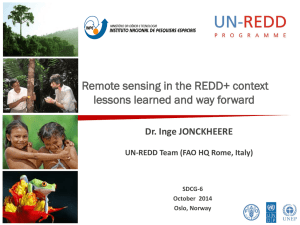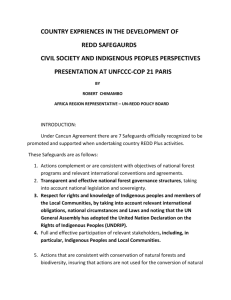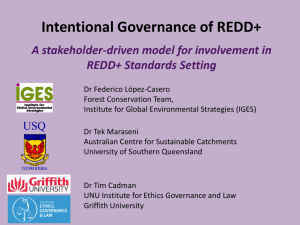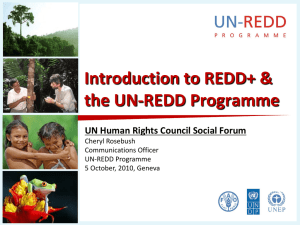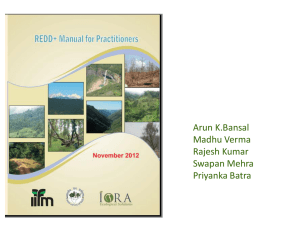Draft Social & Environmental Principles and Criteria
advertisement
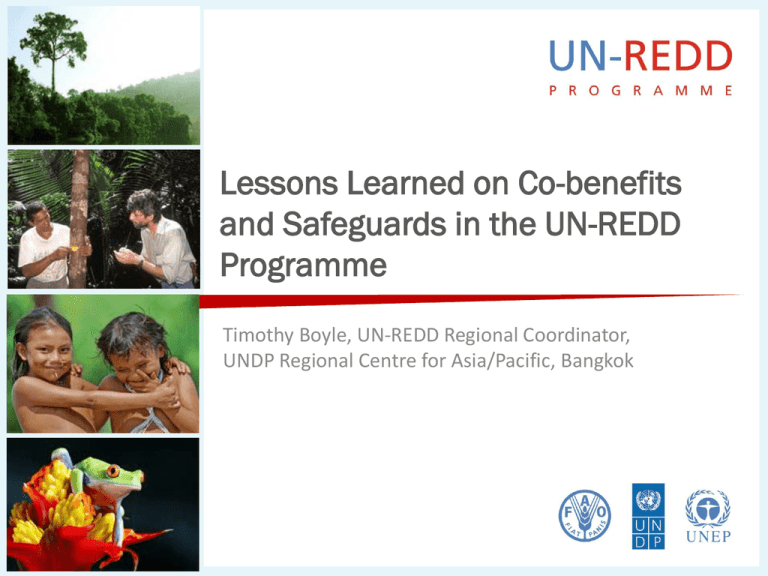
Lessons Learned on Co-benefits and Safeguards in the UN-REDD Programme Timothy Boyle, UN-REDD Regional Coordinator, UNDP Regional Centre for Asia/Pacific, Bangkok Co-benefits in REDD+ All benefits arising from forest land that are not related to carbon or climate mitigation/adaptation Includes, for example, economic benefits from timber/non-timber products; regulation of hydrological processes; biodiversity conservation; soil conservation; aesthetic values, etc. Spatial analysis of multiple benefits Spatial analyses and mapping of multiple benefits, carbon stock densities and other parameters can provide key information to support planning and decision-making on REDD+ at national and subnational scales. Combined with economic parameters such as opportunity costs, spatial analysis would also assist in identifying “low hanging fruits.” Exploring multiple benefits in Cambodia More than 3/4 of the area that is high in carbon and an Important Bird Area is either inside protected areas or in Protection Forests. Exploring multiple benefits in Cambodia 15% of the land that is high in carbon and an Important Bird Area is inside forest concessions. Exploring multiple benefits in Cambodia The amount of carbon within 5 kilometres of forest cover loss represents 66% of Cambodia’s total carbon stock. Exploring multiple benefits in Cambodia Almost 15 % of the area of Economic Land Concessions hold mediumhigh to high carbon stocks. Safeguards in REDD+ REDD+ can create new risks and opportunities for values of forests other than carbon. Safeguards were agreed at UNFCCC COP 16 in Cancun to address this issue. Parties have agreed to “promote and support” these safeguards and to provide information on how the safeguards are “addressed and respected” throughout the implementation of REDD+ activities. The UN-REDD Programme Social & Environmental Principles and Criteria have been further developed in response to this decision. Principles and Criteria for Safeguards The Principles and Criteria will: • Provide the UN-REDD Programme with a framework to ensure that its activities promote social & environmental benefits and reduce risks from REDD+ • Support countries in operationalizing the Cancun agreement’s guidance and safeguards for REDD+ • There are six Principles and 18 Criteria. Principles Principle 1 – Good governance: The program complies with standards of good governance. Principle 2 – Stakeholder livelihoods: The program carefully assesses potential adverse impacts on stakeholders’ longterm livelihoods and mitigates effects where appropriate. Principle 3 – Policy coherence: The program contributes to a low-carbon, climate-resilient and environmentally sound development policy, consistent with commitments under international conventions and agreements. Principles Principle 4 – Protect and conserve natural forest: The program protects natural forest from degradation or conversion to other land uses, including plantation forest. Principle 5 – Maintain and enhance multiple functions of forest: The program increases benefits delivered through ecosystem services and biodiversity conservation. Principle 6 – Minimize indirect adverse impacts on ecosystem services and biodiversity. Social and Environmental Principles and Criteria Principle 1 Democratic governance: The program complies with standards of democratic governance Criterion 1 – Ensure the integrity of fiduciary and fund management systems Criterion 2 – Implement activities in a transparent and accountable manner Criterion 3 – Ensure broad stakeholder participation Social and Environmental Principles and Criteria Principle 2 Principle 2 – Stakeholder livelihoods: The program carefully assesses potential adverse impacts on stakeholders’ long-term livelihoods and mitigates effects where appropriate Criterion 4 – Promote gender equality Criterion 5 – Avoid involuntary resettlement Criterion 6 – Respect traditional knowledge Criterion 7 – Develop equitable benefit distribution systems Relationship with UNFCCC LCA decision Principle Relevant section of Cancun Agreement, Annex I Principle 1 – Democratic governance 2(b) Transparent and effective national forest governance structures, taking into account national legislation and sovereignty 2(d) The full and effective participation of relevant stakeholders, in particular, indigenous peoples and local communities (…) Principle 2 – Stakeholder livelihoods 2(c) Respect for the knowledge and rights of indigenous peoples and members of local communities, by taking into account relevant international obligations, national circumstances and laws, and noting that the General Assembly has adopted the UNDRIP Principle 3 – Policy coherence 2(a) Actions complement or are consistent with the objectives of national forest programmes and relevant international conventions and agreements 2(f) Actions to address the risk of reversals Principle 4 – Protect and conserve natural forests 2(e) Actions are consistent with the conservation of natural forests and biological diversity, ensuring that actions (…) are not used for the conversion of natural forests but are instead used to incentivize the protection and conservation of natural forests and their ecosystem services (…) Principle 5 – Maintain and enhance multiple functions of forest 2(e) Actions (…) incentivize the protection and conservation of natural forests and their ecosystem services (…) 2(e) Actions are (…) used to (…) enhance other social and environmental benefits Principle 6 – Minimize adverse impacts on ecosystem services & biodiversity 2(e) Actions that are consistent with the conservation of (…) biological diversity (…) 2(g) Actions to reduce displacement of emissions Social Principles Risk Identification & Mitigation Tool Social risk identification and mitigation tool is designed to: • Support REDD+ countries to demonstrate how readiness activities meet social and environmental safeguards under UNFCCC • Improve the overall social and environmental sustainability of readiness measures. Based on a series of indicator questions that identify risks, organized under the UN-REDD social principles and criteria. Where risks are identified, risk mitigation measures are suggested. Tool links to consultation process and risk-reporting mechanisms to allow program staff and stakeholders to identify and track risks and mitigation measures. Tool to undergo expert review and pilot application in interested UN-REDD countries. Next steps • Principles & Criteria and the Risk Tool have undergone initial review, now wider review and comments are sought. • Test and refine the Principles & Criteria and support their operationalization. • An interim report on the development of these Principles & Criteria will be submitted to UN-REDD Policy Board in October 2011 • The framework will be finalized after COP 17 UN-REDD Programming for anticorruption • Implemented with UNDP Democratic Governance Group’s Programme on Anti-Corruption for Development Effectiveness (PACDE) • Joint programming on : Capacity development of civil society and other stakeholders Strengthening institutional capacity on anti-corruption (government institutions, anti-corruption agencies, parliamentarians, judiciary, local government authorities) Legal and judicial anti-corruption frameworks Awareness campaigns (started in 2010 with UNODC) Advisory and backstopping support on anti-corruption/governance Tools, methodologies and good practices on anti-corruption and REDD+ (Some) anti-corruption safeguards for REDD+ financial systems Donor coordination Transparent budget and procurement systems Independent public funds Appropriate budget oversight (parliamentarians, civil society, audit agencies) Reconciliation of payments and revenues in audit systems, disaggregated for more transparency Robust conflict resolution mechanisms Building capacity of stakeholders Focus on indigenous peoples and other forest-dependent communities Extensive and authentic civil society engagement central to and prerequisite for UN-REDD (at global and national levels) Implementation of UN Declaration on the Rights of Indigenous Peoples & Free, prior and informed consent are high priority UN-REDD and FCPF harmonizing IP Engagement Guidelines and collaborating with FIP Benefit distribution systems Which institutional and legal frameworks? Identifying beneficiaries Number of hierarchical levels Attribution of carbon/land rights Shape and nature of benefits and resource allocations Existence or absence of recourse and redress mechanisms Participatory decision-making, transparency and accountability For more information thomas.enters@unep.org (Regional center in Bangkok) timothy.boyle@undp.org (Regional center in Bangkok) petteri.vuorinen@fao.org (Regional center in Bangkok) barney.dickson@unep-wcmc.org (UNEP-WCMC) http://www.un-redd.org
